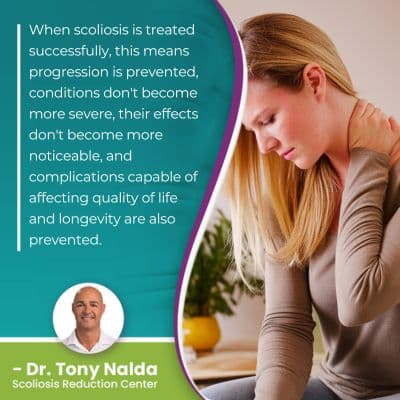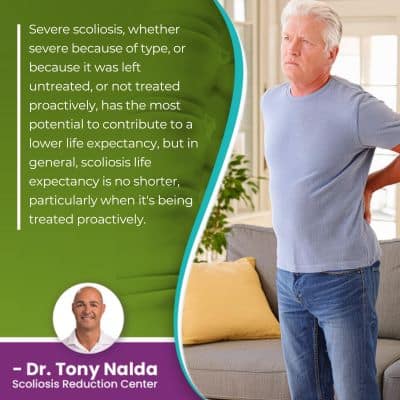How Long Do People With Scoliosis Live? [Explained]

Once a scoliosis diagnosis is given, the most important decision to be made is how to treat it; different treatment approaches shape condition effects and quality of life differently. So while scoliosis isn't overly associated with a lower life expectancy, how a diagnosis is responded to with treatment can have a number of effects.
When it comes to life expectancy and scoliosis, the condition isn't associated with a shorter life expectancy; if particularly severe and/or if left untreated, scoliosis can involve complications that, while rare, could impact a person's longevity, but scoliosis can be highly treatable.
There are different types and severity levels of scoliosis, and as these factors shape a person's life with scoliosis, including longevity, let's start with how condition type and severity are determined.
Table of Contents
Are There Different Types of Scoliosis?
There are different types of scoliosis a person can develop, and type is determined by causation.
In most cases of scoliosis, approximately 80 percent, the cause is unknown; idiopathic scoliosis is the most common type to affect both children and adults, and idiopathic scoliosis isn't clearly associated with a single-known cause.
Idiopathic scoliosis is thought to be multifactorial, meaning caused by a number of variables that can change from patient to patient.
The remaining 20 percent are associated with known causes, and these condition types are considered atypical: neuromuscular scoliosis, degenerative scoliosis, and congenital scoliosis.
Now, there are never treatment guarantees, but typical cases of idiopathic scoliosis can be highly treatable, particularly with early detection and early treatment.
In atypical cases of scoliosis, there is an underlying cause, and this can complicate the treatment process and make these types particularly severe.
Neuromuscular Scoliosis
The most severe condition type that's most likely to contribute to a shorter life expectancy is neuromuscular scoliosis, and that's because the scoliosis develops as a secondary complication of a larger neuromuscular condition.
Neuromuscular scoliosis can be caused by the presence of muscular dystrophy, cerebral palsy, spina bifida, etc., and as the underlying cause is a neuromuscular condition, the neuromuscular condition has to be the focus of treatment.
As neuromuscular scoliosis involves a disconnect between the brain, the spine, and the muscles and/or connective tissues that support the spine, these cases tend to be more severe and can lead to complications that can shorten life expectancy, such as becoming wheelchair bound and unable to move and walk unassisted.
But in typical cases of idiopathic scoliosis that are treated proactively, scoliosis isn't known to cause a shorter life expectancy, but leaving it untreated can lead to complications capable of affecting a person's length and quality of life.
In addition, as a progressive condition, it's important for patients to understand that where a scoliosis is at the time of diagnosis doesn't mean that's where it will stay.
How Bad Can Scoliosis Get?
As a progressive condition, the nature of scoliosis is to get worse over time, and that means the size of the unnatural spinal curve is going to increase, as are the condition's effects.
The more severe a condition is, the more likely it is that its effects are going to be overt, disruptive to life, and impact a person's overall length and quality of life, but here is the good news, although progressive, scoliosis can be highly treatable.
Scoliosis ranges in severity from mild scoliosis to moderate scoliosis, severe and very severe scoliosis, and while we don't know why most cases of scoliosis develop initially, we do understand what makes scoliosis progress: growth.
 When scoliosis is treated successfully, this means progression is prevented, conditions don't become more severe, their effects don't become more noticeable, and complications capable of affecting quality of life and longevity are also prevented.
When scoliosis is treated successfully, this means progression is prevented, conditions don't become more severe, their effects don't become more noticeable, and complications capable of affecting quality of life and longevity are also prevented.
Spinal Fusion Surgery
In addition, for those on the path of traditional scoliosis treatment, spinal fusion surgery is invasive and can be more capable of affecting mortality rates of scoliosis patients, than the scoliosis itself, particularly when treated proactively.
Traditional scoliosis treatment doesn't have a strategy for addressing scoliosis while mild so commonly recommends a watch-and-wait approach, but when scoliosis is mild is precisely the best time to start treatment because it's going to be the simplest to treat, and as significant progression hasn't occurred, condition effects aren't going to be overt and established.
In many cases, it's far more effective to work towards preventing progression and increasing effects than it is to attempt to work towards reversing those effects once they're established.
Spinal fusion surgery can cause:
- Infection
- Nerve damage
- Excessive blood loss
- Adverse reaction to hardware used
The long term complications of spinal fusion surgery can include:
- A noticeable loss in spinal flexibility and range of motion
- Increased pain at the fusion site
- A spine that's weaker and more vulnerable to injury
- Hardware failure over time (rods cracking, breaking, screws coming loose)
So is scoliosis associated with lower life expectancy? Not in typical cases that are treated proactively, but can scoliosis become severe enough to cause complications capable of affecting a person's longevity and quality of life: yes, it can, hence the importance of proactive treatment.
Severe Scoliosis
While there are never treatment guarantees, the earlier a patient is diagnosed with scoliosis, the more potential there is to correct it, and this means applying a conservative nonsurgical treatment approach capable of impacting conditions on every level.
When scoliosis is left untreated and continues to progress, there is nothing counteracting the condition's effects, so they will become more noticeable over time, and in children, the main effect involves postural changes, and in adults, the main scoliosis symptom is pain.
When severe and left untreated, scoliosis can cause lung impairment and digestive issues capable of causing health problems that can indirectly contribute to a lower life expectancy, but is that more related to the scoliosis itself, or more so the lack of treatment?
Scoliosis is a complex spinal condition, but even in cases of thoracic scoliosis that are associated with the development of a rib cage arch capable of disrupting lung function, this isn't considered a common complication, and even if lung function is disrupted, it's likely to go unnoticed by average people; it's patients who place higher-than-average demands on their respiratory systems like professional athletes.
 Severe scoliosis, whether severe because of type, or because it was left untreated, or not treated proactively, has the most potential to contribute to a lower life expectancy, but in general, scoliosis life expectancy is no shorter, particularly when it's being treated proactively.
Severe scoliosis, whether severe because of type, or because it was left untreated, or not treated proactively, has the most potential to contribute to a lower life expectancy, but in general, scoliosis life expectancy is no shorter, particularly when it's being treated proactively.
Conclusion
The National Scoliosis Foundation has rates at close to seven million people currently living with scoliosis in the United States alone, so as a highly-prevalent spinal condition, it's important to understand its effects.
While scoliosis can contribute to health problems capable of contributing to a lower life expectancy, these are not considered common effects, and are more associated with atypical types, particularly severe cases, and/or cases that are left untreated.
There are a number of professional athletes, including Olympic record holders, that were diagnosed with scoliosis as children but have gone on to live their best lives and experience a level of health that most people without scoliosis can't reach.
When it comes to quality of life and expectancy, the best way to ensure scoliosis doesn't cause complications is to be proactive with treatment, and this means being aware of all treatment options available, fully understanding their effects, the risks they carry, and knowing that many patients with scoliosis don't need surgical treatment.
I also want patients on the path of traditional surgical scoliosis treatment to understand that although spinal fusion can straighten a bent spine, the way it does so is contrary to its movement-based design, so will shape long-term spinal health and function.
In addition, there are also risks associated with the procedure itself, and potential complications, that can shorten a patient's life expectancy: another benefit of a more natural nonsurgical treatment approach.
Here at the Scoliosis Reduction Center, patients benefit from a conservative chiropractic-centered treatment approach that works towards preventing progression, increasing condition effects, and the need for invasive surgical treatment.
When treatment is applied early in a condition's progressive line, there are fewer limits to what can be achieved, and the success of professional athletes with scoliosis, along with the proven results of nonsurgical treatment show just how treatable and manageable scoliosis can be.
Scoliosis isn't always an easy condition to live with, but when treated proactively, its effects can be minimized, and patients can see just how treatable it can be.
Dr. Tony Nalda
DOCTOR OF CHIROPRACTIC
After receiving an undergraduate degree in psychology and his Doctorate of Chiropractic from Life University, Dr. Nalda settled in Celebration, Florida and proceeded to build one of Central Florida’s most successful chiropractic clinics.
His experience with patients suffering from scoliosis, and the confusion and frustration they faced, led him to seek a specialty in scoliosis care. In 2006 he completed his Intensive Care Certification from CLEAR Institute, a leading scoliosis educational and certification center.
About Dr. Tony Nalda
 Ready to explore scoliosis treatment? Contact Us Now
Ready to explore scoliosis treatment? Contact Us Now





